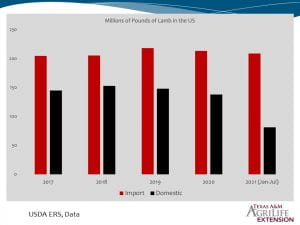Dr. Reid Redden, Associate Professor and Extension Sheep and Goat Specialist, Texas A&M AgriLife Extension Service
(Reid’s Ram-blings: November 2021)
By now  you know that I am a strong proponent of eating and promoting the consumption of lamb and goat meat. Bottom line, it is delicious, but the reasons to include lamb or goat in your meal rotation do not end there. It is nutritious and versatile in the ways it can be prepared. And as producers I believe it is important for us to be advocates of our own products.
you know that I am a strong proponent of eating and promoting the consumption of lamb and goat meat. Bottom line, it is delicious, but the reasons to include lamb or goat in your meal rotation do not end there. It is nutritious and versatile in the ways it can be prepared. And as producers I believe it is important for us to be advocates of our own products.
When we cook and eat lamb and goat ourselves, we also become better advocates for it. I can’t count the number of times, I’ve heard “I only like lamb when Reid cooks it.” Over time, the fear of something different and we gain another advocate. Be Patient!
As a routine customer, I’m always inquiring about the origin of the product. Often, they are sourced from another country. Imported lamb is perceived by many consumers as Continue reading

 pasture is both productive and sustainable. Important decisions such as livestock feed inventory, forage stand replanting, fertility needs, weed control, etc., all hinge on what we see in the pasture. That is why an objective evaluation of a pasture is a valuable tool.
pasture is both productive and sustainable. Important decisions such as livestock feed inventory, forage stand replanting, fertility needs, weed control, etc., all hinge on what we see in the pasture. That is why an objective evaluation of a pasture is a valuable tool.